In This Article
- Key Takeaways About Lab-Grown Diamond Myths
- Myth 1: Laboratory-Cultivated Diamonds Are Not Genuine Diamonds
- Myth 2: Lab-Created Diamonds Look Different
- Myth 3: Lab-Grown Diamonds Are Significantly Cheaper
- Myth 4: Laboratory-Cultivated Diamonds Are Less Durable
- Myth 5: Lab-Created Diamonds Have No Resale Value
- Empowered Choices: The Reality of Lab-Grown Diamonds
- Why Choose After Diamonds?
Dispelling Five Lab-Grown Diamond Myths
This article addresses and debunks five common myths surrounding lab grown diamond jewellery.
Firstly, lab-grown diamonds are genuine, possessing identical chemical properties and certified authenticity by organizations such as the Gemological Institute of America (GIA) and the International Gemological Institute (IGI). Contrary to popular belief, they are visually indistinguishable from their mined counterparts.
Their pricing isn't always significantly lower, often reflecting detailed production methods and market trends.
These diamonds endure everyday wear with the same durability, scoring a perfect 10 on the Mohs scale.
The notion that they have no resale value is fading; these gems are gaining recognition as valuable keepsakes. Read on to understand their true value.
Key Takeaways About Lab-Grown Diamond Myths
- Authenticity: Lab-created diamonds have the same chemical and physical properties as natural diamonds, as certified by respected institutions like GIA and IGI.
- Visual Appearance: Both lab-created and natural diamonds are visually identical to the naked eye, sharing the same carbon crystal structure and hardness.
- Pricing: Even though the price of lab-created diamonds can be lower per carat than natural ones, the way that jewellery buyers choose their jewellery means that the price actually paid per piece may not be much lower than natural diamond jewellery.
- Symbolism: Lab-created diamonds symbolize love and commitment, with a growing preference among consumers for ethical and environmentally friendly choices.
- Misconceptions: Misunderstandings about lab-created diamonds arise from cultural perceptions and misinformation, with specialists needed to pinpoint subtle differences.
Myth 1: Laboratory-Cultivated Diamonds Are Not Genuine Diamonds
A common myth about lab-grown diamonds is that they lack the authenticity of their natural counterparts, but this is not accurate.
The Federal Trade Commission (FTC) has ruled that lab-grown diamonds are, in fact, real diamonds. According to their 2018 guidelines, "A diamond is a diamond, no matter whether it is grown in a lab or comes out of the ground."These gems have the same chemical and physical properties, making them indistinguishable to the naked eye. Certified and assessed by the same stringent criteria, laboratory-created diamonds hold their own among gemstones, earning respect from experts and industry leaders.
Mens Signet Ring With 0.10ct Lab Diamonds in D/VVS 925 Silver
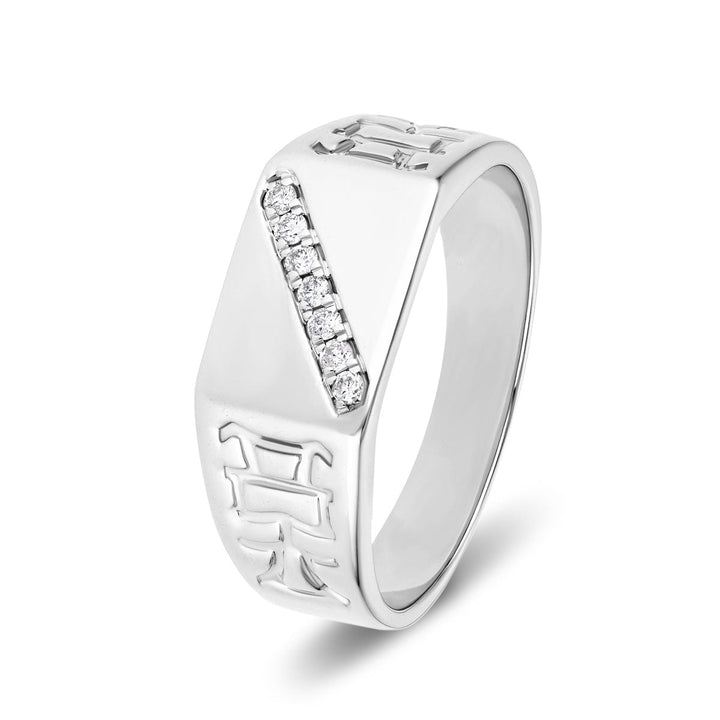
£165.00
£255.00
Introducing the Men's Signet Ring, a masculine and striking addition to any ensemble. This piece features 0.10ct of lab-created diamonds, chosen for their real, dazzling beauty and set in a classic claw setting to enhance their brilliance. Crafted from premium… read more
Explanation of the Myth
Many people mistakenly believe that lab-created diamonds are not real diamonds. This misconception likely stems from traditional marketing tactics and the assumption that only natural origins confer authenticity.
However, lab-created diamonds are ethically sourced, offering an option for buyers concerned about the environmental and social impacts of mining. They are chemically and physically identical to mined diamonds, reflecting the same brilliance and hardness.
Lab-created diamonds represent innovation and responsibility, challenging outdated beliefs and offering a new perspective where luxury and ethics coexist.
Scientific Facts About Laboratory-Grown Diamonds
Both natural and lab-grown diamonds are formed through processes that result in the same carbon structure, leading to identical physical properties and brilliance.
Key points include:
- **Authenticity:** Lab-grown diamonds are chemically and physically identical to mined diamonds.
- **Environmental Impact:** Lab-created gems often have a smaller ecological footprint, appealing to environmentally conscious consumers.
- Consumer Perceptions: The ethical production and beauty of these gems are driving their rising acceptance.
- Formation: In laboratories, diamonds are formed under conditions that mimic the Earth's mantle, demonstrating technological advancement.
Comparison of Chemical and Physical Properties
Both mined and lab-grown diamonds share the same carbon crystal structure, giving them their renowned hardness and sparkle.
Chemical composition analysis reveals that both types are composed of pure carbon atoms arranged in a cubic lattice. This identical structure ensures equal robustness and resilience in structural integrity assessments.
Additionally, comparisons of optical properties show that lab-grown diamonds exhibit the same fire, brilliance, and scintillation as natural diamonds.
Lab Diamond Three Stone Bangle 0.75ct in D/VVS 18k Rose Gold
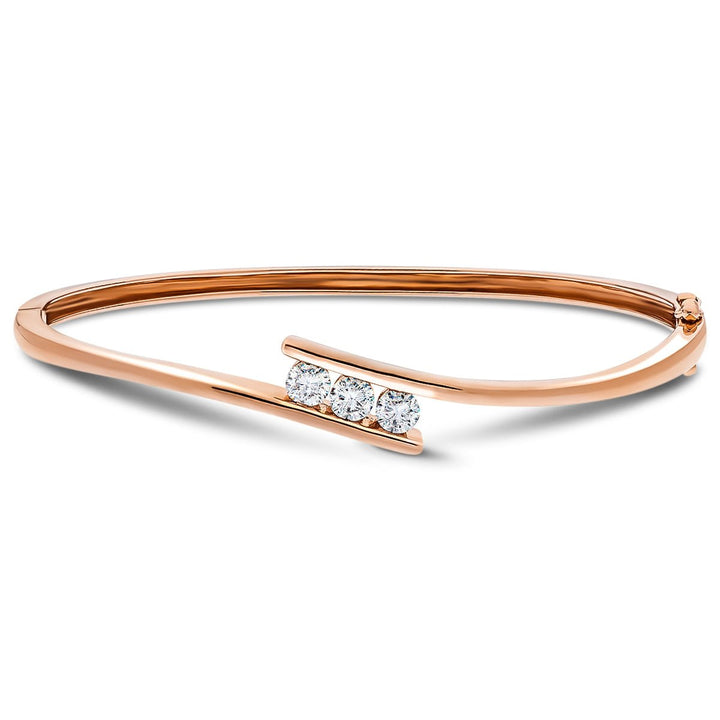
£2,430.00
£5,395.00
Discover the epitome of elegance with the Lab Diamond Three Stone Bangle, a masterpiece that combines striking design with modern style. This exquisite piece features 0.75ct of real diamonds in a tension setting, creating a dazzling display of brilliance and… read more
Certification and Grading of Laboratory-Grown Diamonds
Lab-grown diamonds undergo the same rigorous certification and grading processes as natural diamonds.
These diamonds receive comprehensive evaluations by respected organizations such as the GIA and IGI.
Key points include:
- Market Trends: Lab-grown diamonds reflect evolving consumer perceptions and preferences.
- Certification: Certification ensures authenticity and quality, fostering trust among buyers.
- Grading: Both lab-grown and natural diamonds are graded based on the 4Cs (cut, colour, clarity, carat weight).
- Ethical Implications: Lab-grown diamonds reduce environmental and societal impacts compared to mined diamonds.
Lab Diamond Cluster Pendant Necklace 0.25ct D/VVS in 9k White Gold
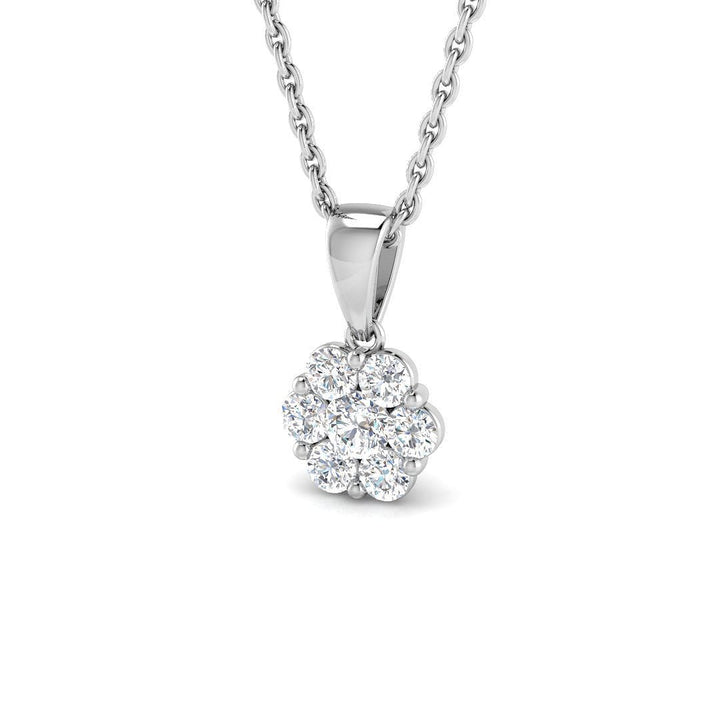
£225.00
£505.00
Discover the exquisite charm of our Lab Diamond Cluster Pendant Necklace, boasting a total diamond weight of 0.25ct with an exceptional D/VVS quality. Each ethically sourced, real diamond is masterfully cut into a round shape, brilliantly capturing light in every… read more
Specialist Views and Industry Acknowledgment
Experts and industry insiders have long dismissed the misconception that lab-grown diamonds are not real diamonds.
Professional insights reveal that lab-grown diamonds possess the same physical, chemical, and optical properties as mined diamonds. This fact aligns with industry standards, confirming their authenticity.
Consumer perception has significantly shifted, with increasing acceptance of lab-grown diamonds as a genuine, eco-friendly option.
Esteemed gemological institutes recognize and certify these gems, affirming their worth.
Myth 2: Lab-Created Diamonds Look Different
Some believe that lab-grown diamonds must appear different, perhaps lacking shine or depth.
However, both natural and lab-created diamonds develop through similar processes, whether deep within the Earth or in a controlled laboratory environment.
In fact, without specialized equipment, even experts often struggle to differentiate between the two, as both kinds adhere to the same strict grading standards and display identical visual characteristics.
Isla Pink Lab Oval Diamond Halo Engagement Ring 2.50ct in 18k Yellow Gold
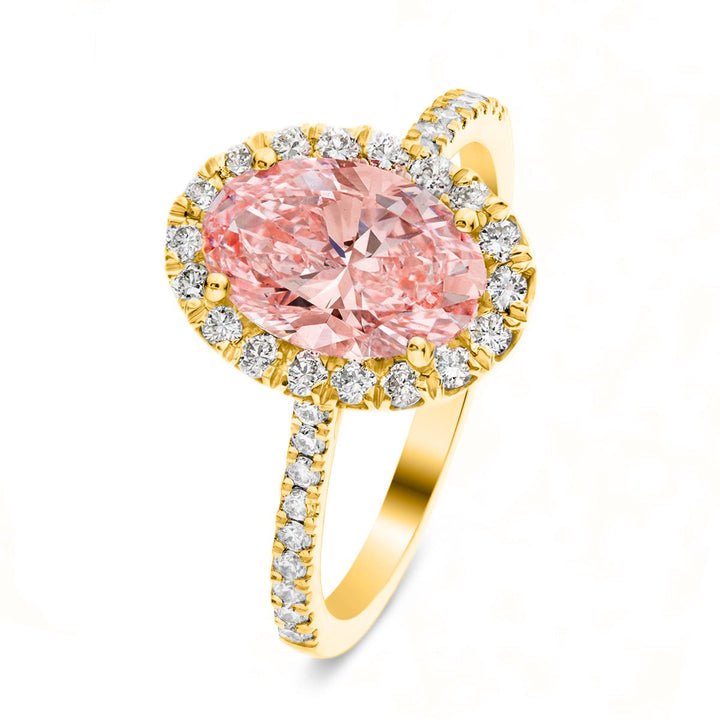
£2,250.00
£4,745.00
The Isla Pink Lab Oval Diamond Halo Engagement Ring is breathtaking, blending vibrant colour with classic design. At its heart lies a 1.50ct vivid pink, VS quality lab-grown oval diamond, certified by IGI for its exceptional clarity and authenticity. This… read more
Origin of This Misconception
The misunderstanding that lab-grown diamonds look different from natural diamonds likely originates from a lack of understanding about their creation process. This myth is rooted in several factors that shape perceptions:
- Cultural Perceptions: Society has been conditioned to value natural diamonds more highly.
- Historical Context: For centuries, natural diamonds have been symbols of wealth and romance.
- Consumer Education: Many consumers are not fully informed about the similarities between lab-grown and natural diamonds.
- Misinformation: Some marketing campaigns have disseminated inaccurate information in an attempt to protect the natural diamond industry.
By examining these factors, it becomes clear how deeply these misconceptions are embedded in collective consciousness. Understanding these roots can help shift perceptions and promote acceptance of modern advancements.
Explanation of Diamond Formation Process (Natural vs. Lab-Grown)
In the natural world, diamonds form over millions of years deep within the Earth's mantle, under immense pressure and heat. While this natural process creates beautiful gems, it raises concerns about the ethics of diamond mining and environmental impact.
Laboratory-grown diamonds are created in a matter of weeks using scientific methods that replicate these natural conditions. High-pressure high-temperature (HPHT) or chemical vapor deposition (CVD) techniques produce diamonds that are identical in atomic structure to mined ones.
Lab-grown diamonds offer a compelling alternative, providing beauty without the environmental harm or ethical dilemmas associated with mining. They represent a choice aligned with sustainability and ethical sourcing.
Lab Diamond Solitaire Stud Earrings 3.00ct G/VS in 18k Yellow Gold
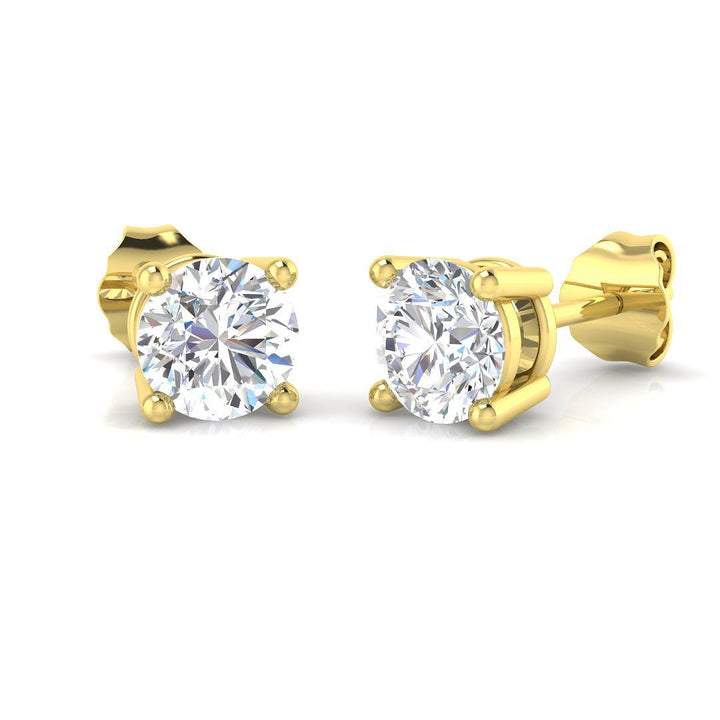
£1,295.00
£4,121.00
Embrace glamour with the Lab Diamond Solitaire Stud Earrings, featuring 3.00 carats of G/VS-graded lab-grown diamonds set in 18k yellow gold. These round solitaire diamond earrings are designed and handcrafted in the UK, with a secure claw setting for added… read more
Comparison of Visual Features
Lab-grown diamonds are virtually indistinguishable from their natural equivalents.
A comparison of visual appeal shows that the brilliance and fire of both types of diamonds are strikingly similar. Optical performance analysis confirms that light refraction and dispersion are identical.
Key points include:
- Clarity: Both types exhibit similar clarity, with minimal inclusions.
- Colour: Lab-grown diamonds match natural diamonds in colour grading.
- Cut Quality: Precision in cutting ensures identical visual splendour.
- Aesthetic Perception: Any variations are imperceptible to the naked eye.
The beauty of a diamond, whether natural or lab-grown, transcends its origin, showcasing timeless allure.
Isla Blue Lab Oval Diamond Halo Engagement Ring 2.50ct in Platinum
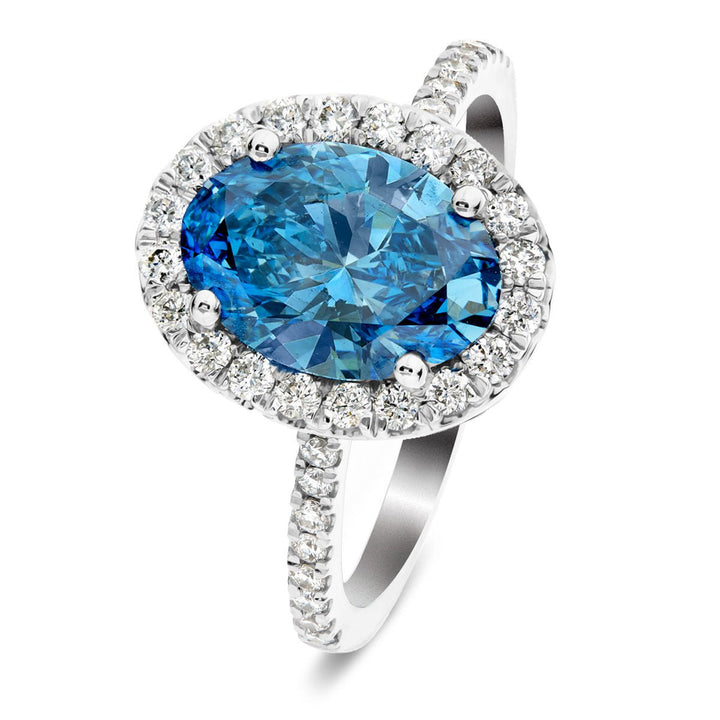
£2,330.00
£4,915.00
The Isla Blue Lab Oval Diamond Halo Engagement Ring embodies luxurious design and impeccable craftsmanship. At its heart lies a vivid blue, VS quality, 1.50ct lab-grown oval diamond, boasting an IGI certification that underscores its authenticity and quality. This magnificent… read more
Grading Standards for Both Types of Diamonds
Diamond grading standards set the benchmark for assessing the quality and value of precious gems, whether they are lab-grown or natural.
The grading criteria for lab-grown and natural diamonds are virtually identical. Both types undergo meticulous examination based on the 4Cs: carat, clarity, colour, and cut.
However, market perception factors can create a divide, often rooted in tradition and misconceptions. Consumer education initiatives aim to bridge this gap, highlighting that, visually and structurally, these diamonds are indistinguishable.
Dr. James Shigley, a distinguished research fellow at the Gemological Institute of America (GIA), states: "The physical and optical properties of lab-grown diamonds are essentially identical to those of natural diamonds."Challenge for Experts to Differentiate Without Specialized Equipment
Identifying laboratory-created diamonds without specialized equipment can be challenging, even for experienced gemologists.
Visual identification between lab-grown and natural diamonds often requires expert techniques and advanced tools. The perception that lab-grown diamonds are easily distinguishable is a myth.
Key points:
- Expert Techniques: Specialized knowledge is needed to detect subtle differences.
- Visual Identification: To the naked eye, both types appear identical.
- Market Perception: Many believe lab-grown diamonds are visually distinct, but this is not the case.
- Intricate Details: Only advanced equipment can reveal their true origin.
Understanding this distinction enhances appreciation of these gemstone's intricate beauty.
Nancy Lab Diamond Halo Pear Engagement Ring 3.75ct G/VS in Platinum

£3,670.00
£7,001.00
Indulge in pure luxury with the stunning Nancy Lab Diamond Halo Pear Engagement Ring, meticulously crafted by hand in the UK. This ring features a captivating 3.75-carat total weight of G/VS-graded diamonds, including a magnificent pear-shaped diamond at the centre… read more
Myth 3: Lab-Grown Diamonds Are Significantly Cheaper
While lab-grown diamonds are generally less expensive than natural diamonds, the pricing difference is more nuanced than many people believe.
Lab-grown diamonds typically cost about 30-50% less than natural diamonds of comparable size and quality. This price difference, while significant, is not as drastic as some myths suggest. The cost savings are due to the more efficient production process of lab-grown diamonds compared to the resource-intensive mining of natural diamonds.
Many consumers approach diamond buying with a fixed budget in mind. With lab-grown diamonds, this budget often allows for:
- A larger carat size
- Higher quality in terms of cut, color, or clarity
- Or a combination of both
For example, a 2-carat lab-created round diamond might cost around £4,000, while a mined diamond of the same size and quality could be priced at about £16,000. This means that a significantly larger or higher-quality lab-grown diamond can be acquired for the same budget.
The price of lab-grown diamonds has been decreasing over time due to improved production technologies. This trend may continue, potentially widening the price gap with natural diamonds in the future.
Stephen Morisseau, a spokesperson for the GIA, notes: "Lab-grown diamonds are less expensive than natural diamonds of comparable size and quality, but they're not cheap."Clarification of the Price Difference
While it is commonly believed that lab-grown diamonds are significantly cheaper than their natural counterparts, this is not always the case. Affordability often intersects with factors like price perception psychology and fluctuations in market demand. Many buyers can expect to save up to 50% by choosing lab-grown diamond jewellery compared to mined diamond jewellery.
Remember, that when buying jewellery, the cost of the precious metals used in the setting, design work and manufacturing all factor into the cost of the finished piece. This means that a smaller lab-grown diamond will be a smaller proportion of the cost than a larger diamond in a similar piece of jewellery.
Important considerations:
- Market Fluctuations: Prices can vary due to changes in market demand.
- Consumer Education: Awareness of actual costs helps consumers make informed decisions.
- Brand Influence: Prestige and marketing strategies can affect perceptions and pricing.
- Quality and Rarity: These factors remain crucial in determining price.
Lab-grown diamonds are sometimes less costly, but not universally so. Understanding the broader picture allows for informed choices based on reality rather than myth.
Lab Diamond Heart Pendant Necklace 0.25ct in 9k Rose Gold
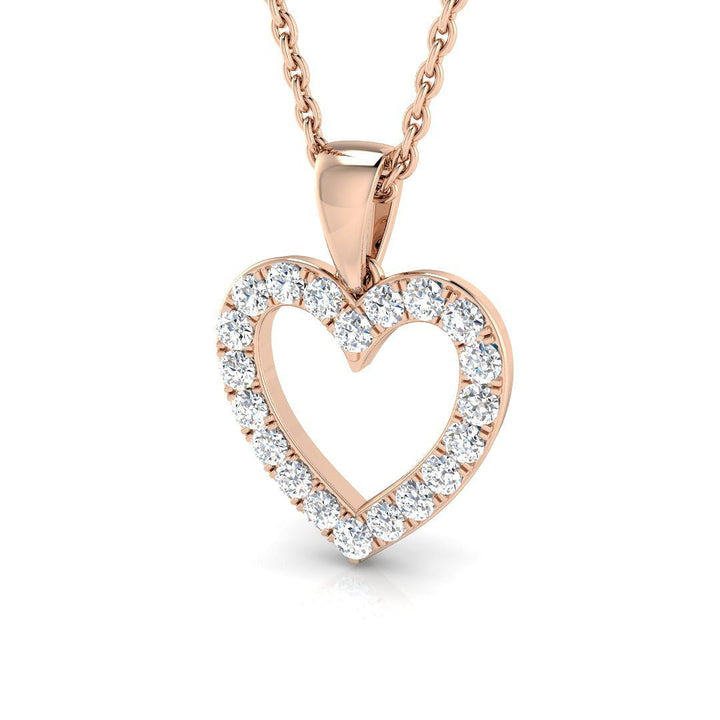
£300.00
£675.00
This exquisite Lab Diamond Heart Pendant Necklace features a total diamond weight of 0.25ct, encapsulating luxury and precision. Each lab-created diamond is meticulously chosen for its superior quality, boasting a D/VVS grade that reflects exceptional clarity and brilliance. The heart-shaped… read more
Factors Affecting the Price of Laboratory-Created Diamonds
Examining the components that affect the price of lab-grown diamonds reveals that the situation is complex.
Supply chain dynamics significantly impact pricing, as the cultivation and distribution of these gemstones are intricate and resource-intensive. Consumer perceptions also shape the market; lab-grown diamonds often face stigma compared to their natural equivalents.
However, ethical considerations add appeal, as these diamonds avoid the issues associated with mining. Collectively, these aspects create a complex pricing landscape.
Factors to consider:
- Market Demand: Shifts in consumer interest can affect prices of both natural and lab-grown diamonds.
- Production Costs: While less expensive to produce, lab-grown diamonds still involve significant expenses.
- Retailer Markups: Both types of diamonds can experience similar pricing strategies.
- Perceived Value: Consumer perceptions play a fundamental role in determining final prices.
Understanding these elements helps demystify the complex diamond market.
Four Stone Lab Diamond Eternity Ring 2.80ct D/VVS in 18k White Gold
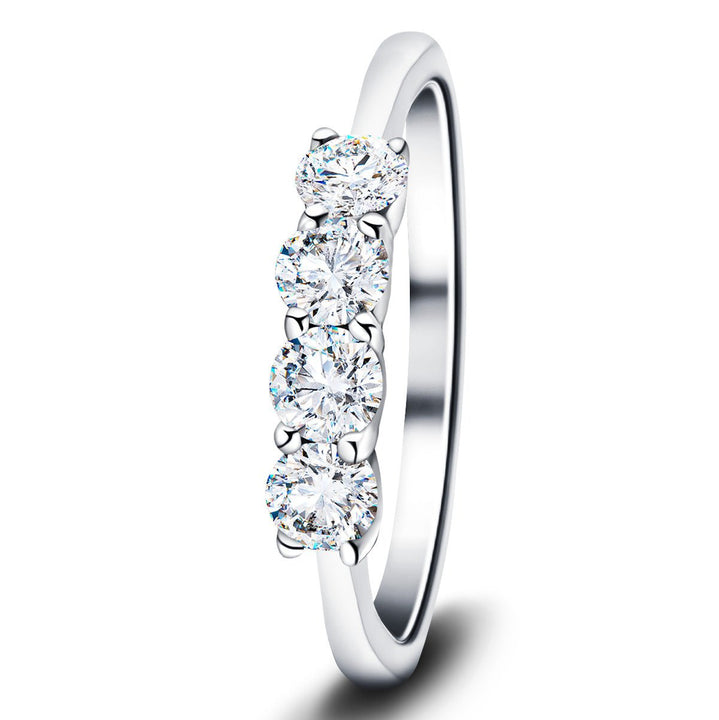
£2,650.00
£5,141.00
Declare your love with this exquisite Four Stone Lab Diamond Eternity Ring, featuring four sparkling lab-grown round diamonds with a combined weight of 2.80 carats. The high-quality diamonds are rated D/VVS and set in 18k white gold. The ring is… read more
The Value Proposition of Laboratory-Grown Diamonds
While lab-grown diamonds can be more affordable, their value proposition extends beyond cost. Investing in lab-grown diamonds supports sustainability and ethical sourcing, aligning purchases with values that resonate within communities concerned about environmental impact.
Selecting lab-grown diamonds embraces a future where consumer preferences demonstrate a commitment to the planet and its inhabitants. This choice is not just about saving money; it is about making a statement of conscientiousness and unity.
Lab-grown diamonds offer an opportunity to celebrate integrity, embodying beauty that is both visible and meaningful. They represent more than a choice; they are a statement of values.
Future Price Trends and Market Dynamics
The evolving landscape of diamond pricing challenges the idea that lab-created diamonds will always be significantly less expensive. As supply chain efficiencies change, prices respond to various market forces.
Consumer demand plays a vital role, influencing the balance between affordability and desirability. Market projections suggest that while lab-grown diamonds may currently appear more accessible, this trend is not permanent.
- Supply Chain Enhancements: Could reduce costs, but not indefinitely.
- Consumer Demand: Rising popularity can push prices up.
- Market Projections: Indicate potential price stabilization rather than continuous decline.
- Technological Advancements: Impact both price and quality.
In conclusion, while lab-grown diamonds offer a cost advantage, consumers often choose to allocate their budget differently rather than simply spending less overall. This nuanced understanding aligns with typical approaches to diamond jewelry purchases and is key to obtaining the best value within a given budget.
Maya Lab Diamond Bezel Solitaire Engagement Ring 4.00ct D/VVS Platinum
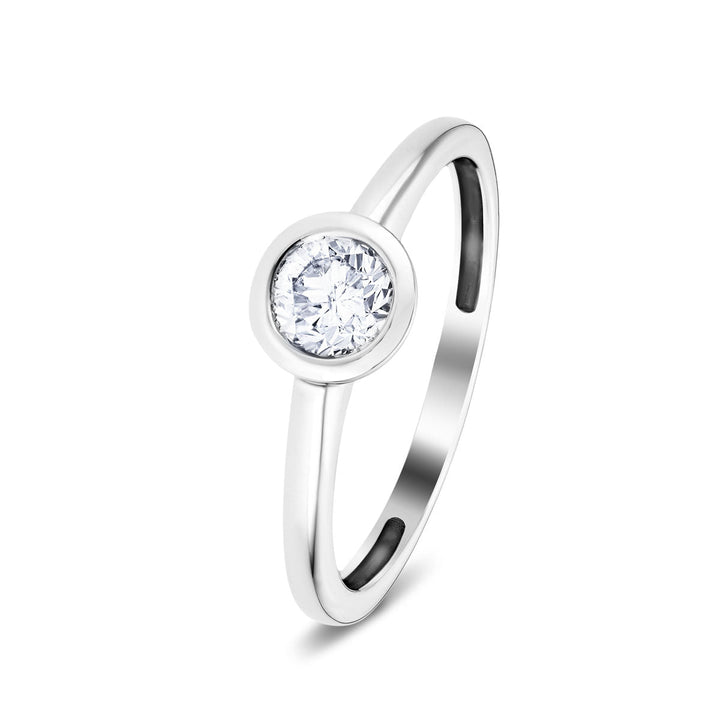
£9,495.00
£18,116.00
Fall in love with the Maya Lab Diamond Bezel Solitaire Engagement Ring. This stunning ring features a 4.00 carat D/VVS-graded lab-created diamond, bezel-set in platinum, the epitome of luxury. Certified by IGI and UK hallmarked, this ring boasts a solitaire… read more
Myth 4: Laboratory-Cultivated Diamonds Are Less Durable
Contrary to the belief that lab-created diamonds are less robust, both lab-grown and natural diamonds score a perfect 10 on the Mohs scale of hardness, indicating equal durability.
These diamonds endure everyday wear with the same resilience, making them suitable for engagement rings and daily jewelry. They require similar care and maintenance to retain their brilliance.
Explanation of Diamond Hardness and Resilience
Lab-grown diamonds possess the same chemical structure as natural diamonds, ensuring identical hardness and resilience.
Both types of diamonds exhibit lasting strength, standing strong against the effects of time. Their hardness means they resist scratches and maintain their sparkle with proper care.
Key considerations:
- Chemical Composition: Identical carbon structures result in equal hardness.
- Scratch Resistance: Both types effectively resist scratches.
- Maintenance Requirements: Regular cleaning and safe storage keep them shimmering.
- Longevity: Designed to last, they make enduring symbols of commitment.
Lab Diamond Channel Set Drop Earrings 0.80ct D/VVS in 9k Yellow Gold
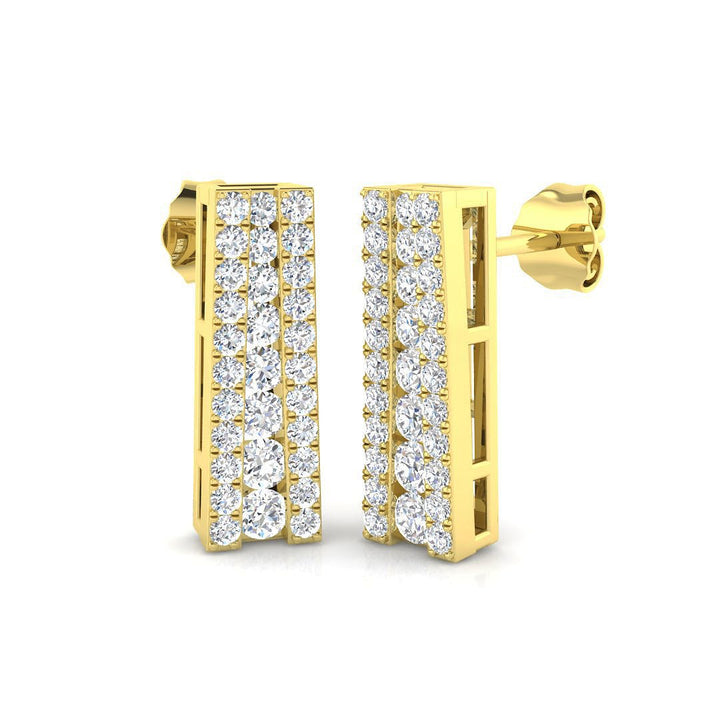
£560.00
£1,255.00
Elevate your style with these exquisite Lab Diamond Channel Set Drop Earrings, boasting a total diamond weight of 0.80ct of D/VVS quality. Crafted in lustrous 9k yellow gold, these earrings feature a striking, modern design with channel-set diamonds in a… read more
Mohs Scale Rating for Laboratory-Grown Diamonds
Both lab-grown and natural diamonds achieve a perfect 10 on the Mohs scale, signifying unparalleled hardness.
In detailed durability analyses, lab-grown diamonds mirror their natural counterparts in resilience. Their structural integrity ensures they withstand daily wear and maintain their brilliance over time.
According to the International Gemological Institute (IGI), "Lab-grown diamonds have the same hardness, durability, and chemical composition as natural diamonds."Comparison of Wear and Tear Resistance
Lab-grown diamonds display the same resistance to wear and tear as their natural equivalents.
Key points:
- Hardness: Both types achieve a flawless 10 on the Mohs scale.
- Wear Resistance: They withstand daily activities without losing their lustre.
- Maintenance: Similar care routines apply to both, ensuring longevity.
- Longevity Factors: Both are designed to be lasting symbols of love and commitment.
Layla Lab Diamond Halo Princess Engagement Ring 1.50ct D/VVS in 18k Yellow Gold
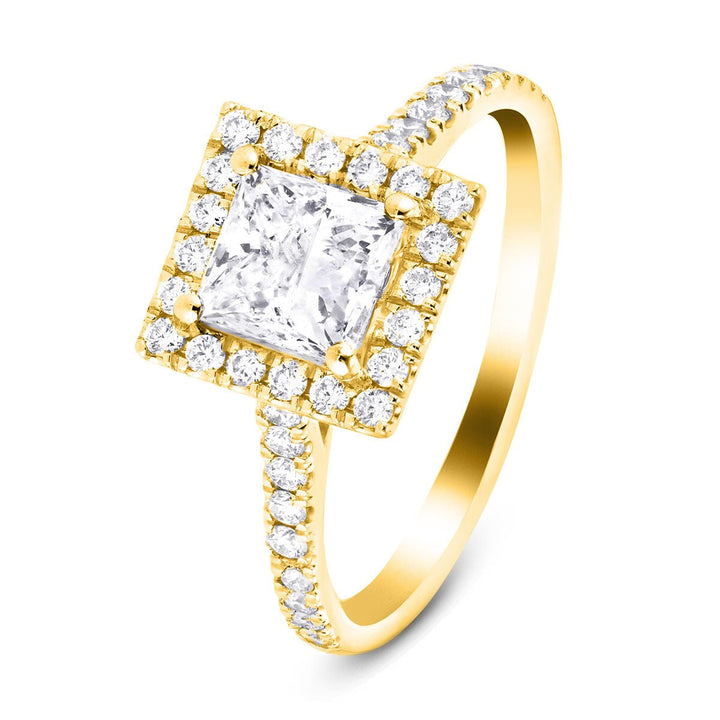
£1,690.00
£3,221.00
This Layla Lab Diamond Halo Princess Engagement Ring is a stunning example of expert craftsmanship, handcrafted in the UK using high-quality materials. Featuring 1.50 carats of diamonds. A lovely 1.00 carat princess-cut diamond certified D/VVS quality sits at the centre… read more
Suitability for Everyday Jewellery, Including Engagement Rings
Lab-grown diamonds are ideal for everyday jewellery, including engagement rings.
They match the resilience of natural diamonds and can withstand the demands of daily life. Their durability ensures they remain a constant sparkle that aligns with contemporary engagement trends.
Care and Upkeep Similarities
Synthetic diamonds do not require special care or maintenance compared to natural diamonds.
Both types of diamonds possess the same durability and brilliance, necessitating identical care methods to maintain their beauty.
Recommendations:
- Regular Cleaning: Use mild soap and water with a soft brush.
- Avoid Harsh Chemicals: Keep diamonds away from bleach and chlorine.
- Routine Checks: Periodically inspect for loose settings.
- Proper Storage: Store separately to avoid scratches.
Lab Diamond Emerald Halo Earrings 1.00ct D/VVS in 9k Yellow Gold
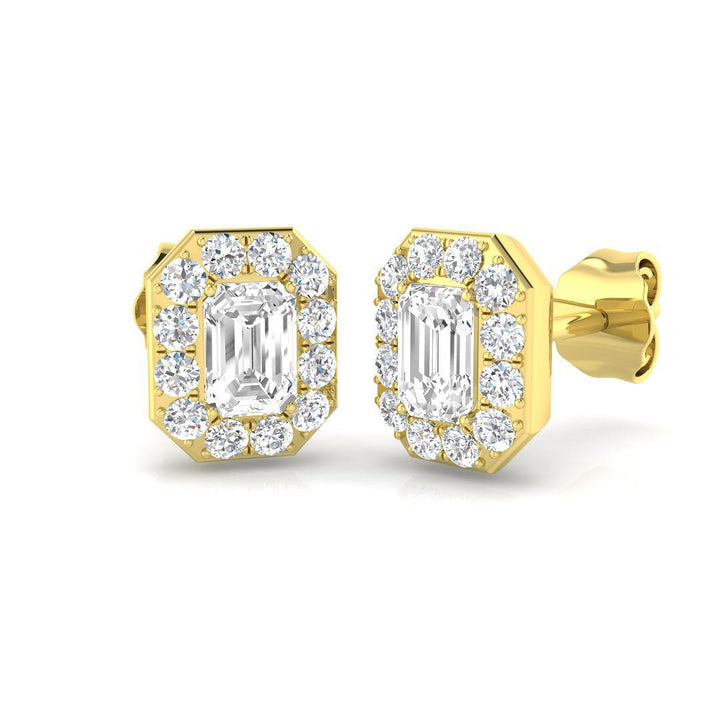
£535.00
£1,195.00
Discover the exquisite elegance of our Lab Diamond Emerald Halo Earrings, boasting a total diamond weight of 1.00ct with a D/VVS quality, set in luxurious 9k yellow gold. These earrings feature a mesmerising emerald-cut central diamond encircled by sparkling round… read more
Myth 5: Lab-Created Diamonds Have No Resale Value
When considering the resale value of lab-grown diamonds, the market suggests a different story than the belief that they are valueless.
Factors such as quality, demand, and emerging trends in the secondary market are shaping a new narrative that competes with natural diamonds.
While some see diamonds as personal treasures, others regard them as financial assets, and this dual perception influences their resale potential.
Current State of the Second-Hand Market for Laboratory-Created Diamonds
The second-hand market for lab-grown diamonds is steadily gaining momentum.
Astute buyers are recognizing the value of these gems, altering consumer perspectives. Market trends show increasing acceptance and appreciation, making lab-grown diamonds a feasible investment.
Key aspects:
- Resale Strategies: Innovative platforms are enhancing their appeal.
- Market Trends: Rising demand for sustainable options elevates the market.
- Consumer Perceptions: Awareness expands willingness to invest.
- Community Influence: Shared values foster a sense of community.
Pear Drop Lab Diamond Earrings 2ct D/VVS in 9k Rose Gold
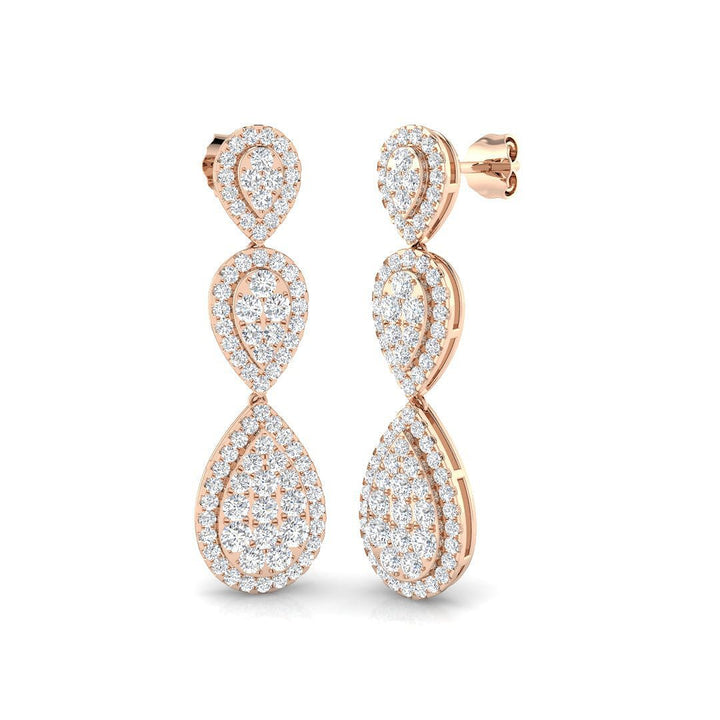
£1,165.00
£2,595.00
These exquisite Pear Drop Lab Diamond Earrings, boasting an impressive 2ct D/VVS diamond quality, are the epitome of modern elegance. Designed and handcrafted in the UK, they feature a captivating three-tier design, each tier adorned with lustrous pear-shaped diamond clusters.… read more
Factors Influencing Resale Value
Several factors determine the resale value of lab-created diamonds:
- Market Demand: Shifts in consumer interest affect value.
- Consumer Perception: Growing acceptance enhances resale potential.
- Investment Strategies: Aligning with market trends can enhance value.
- Ethical Considerations: Sustainability adds to their appeal.
Understanding these factors helps in making informed decisions regarding investment in lab-grown diamonds.
Emerging Secondary Market Trends
As consumer perceptions shift towards the ethical and environmental benefits of lab-grown diamonds, the secondary market is experiencing significant trends.
Key developments:
- Increased Demand: More buyers are seeking lab-grown options.
- Enhanced Resale Platforms: Specialized marketplaces are emerging.
- Eco-Conscious Choices: Sustainability priorities elevate appeal.
- Recognition and Certification: Legitimacy is growing.
These trends indicate that lab-grown diamonds are not only holding value but are flourishing in the secondary market.
Edahn Golan, an independent diamond industry analyst, observes: "While the resale market for lab-grown diamonds is still developing, these stones do have value. As with natural diamonds, factors like size, quality, and market demand will influence their resale price."Comparison with Natural Diamond Resale Value
The dynamic market environment is challenging the belief that lab-grown diamonds have no resale value.
While natural diamonds have long been cherished, lab-grown gems are forging their own niche. As the market adjusts, perceptions of value are changing, demonstrating that these diamonds can indeed be a smart investment.
Lab Diamond Vintage Drop Earrings 2ct D/VVS in 9k White Gold
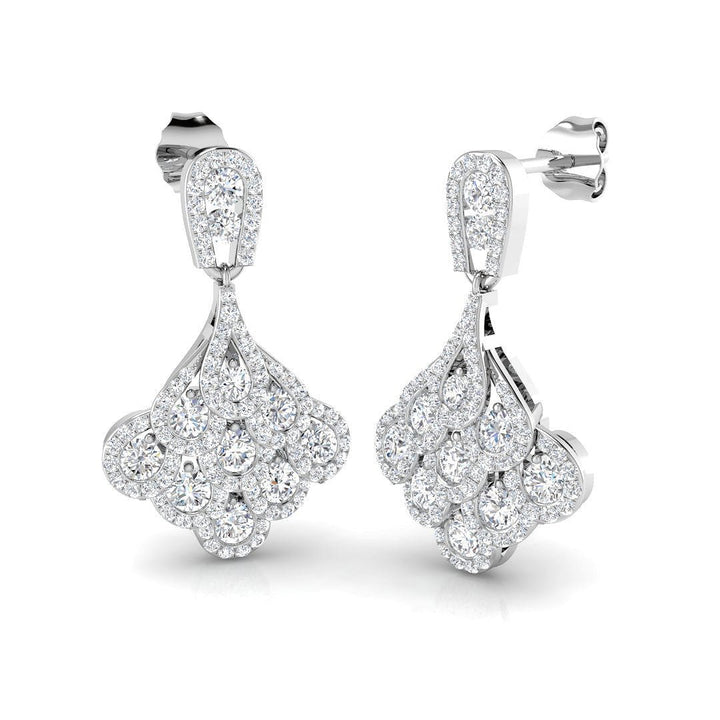
£1,165.00
£2,595.00
These exquisite Lab Diamond Vintage Drop Earrings, featuring a total of 2ct D/VVS quality diamonds, radiate elegance and modern sophistication. Set in luxurious 9k white gold, their design is both striking and contemporary, with every inch glittering with diamond encrustation.… read more
Perspective on Diamonds as Personal vs. Financial Investments
Diamonds often carry immense emotional value, marking life's significant moments.
- Personal Significance: Commemorate love, commitment, and achievements.
- Investment Potential: Lab-grown diamonds are increasingly viewed as valuable assets.
- Emotional Value: Harbour memories and symbolize profound connections.
- Sustainability: Ethically produced, they are eco-friendly choices.
Lab-grown diamonds are not merely commodities; they are treasured mementos of personal experiences. Their worth is found not only in resale but in the stories they carry and the connections they represent.
Lab Diamond Paperclip Earrings 0.55ct D/VVS in 925 Silver
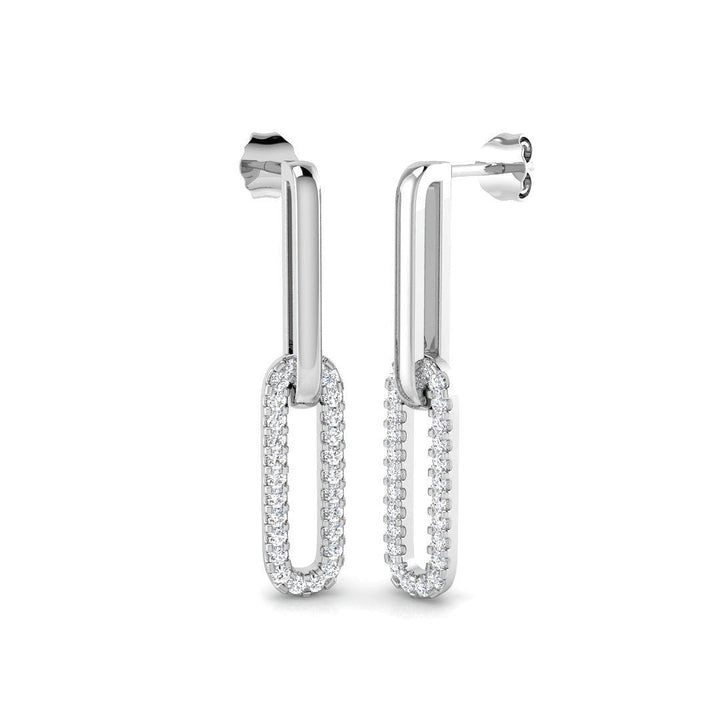
£370.00
£635.00
Discover the epitome of contemporary elegance with our Lab Diamond Paperclip Earrings, boasting a total diamond weight of 0.55ct with D/VVS quality. Meticulously crafted in 925 sterling silver, these earrings present a striking two-link design, the lower link adorned with… read more
Empowered Choices: The Reality of Lab-Grown Diamonds
The myths surrounding lab-grown diamonds have been addressed and dispelled. These diamonds are real, sparkle just as brightly, and hold their own in durability and value.
Misconceptions should no longer influence decisions because knowledge provides clarity.
Lab-grown diamonds can be embraced with confidence, knowing that they represent an informed and ethical choice. The truth, as clear and dazzling as the diamonds themselves, is now available to cherish.
Lily Lab Pear Diamond Solitaire Engagement Ring 0.70ct G/VS Platinum
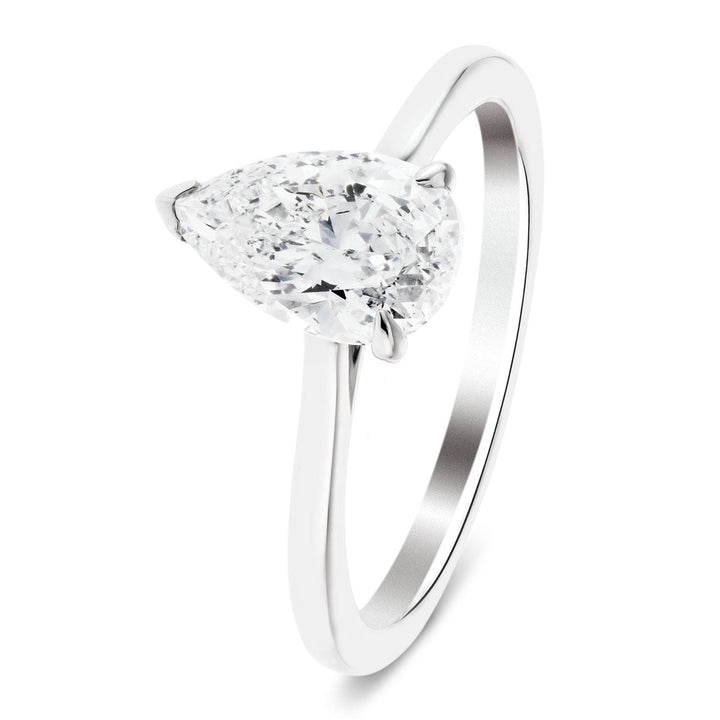
£800.00
£1,526.00
Experience the beauty of the Lily Lab Pear Diamond Solitaire Engagement Ring, meticulously crafted in the UK. This ring features a stunning 0.70-carat total weight of G/VS IGI-certified lab-grown diamonds set in platinum, with a pear-shaped diamond as the centrepiece.… read more
Why Choose After Diamonds?
- Exquisite, ethically-sourced lab-grown diamonds
- Unique designs handcrafted by skilled British artisans
- Free, insured worldwide delivery
- 30-day return and exchange policy for your peace of mind
Whether you're searching for the perfect engagement ring, a special gift, or a timeless piece to add to your collection, we invite you to explore our range of lab-grown diamond jewellery.
Ready to shine? Visit our online store today and discover how After Diamonds can help you make a brilliant, ethical choice that doesn't compromise on quality or beauty.
Don't let myths hold you back from owning a piece of the future. Experience the After Diamonds difference—where cutting-edge science meets timeless elegance.





